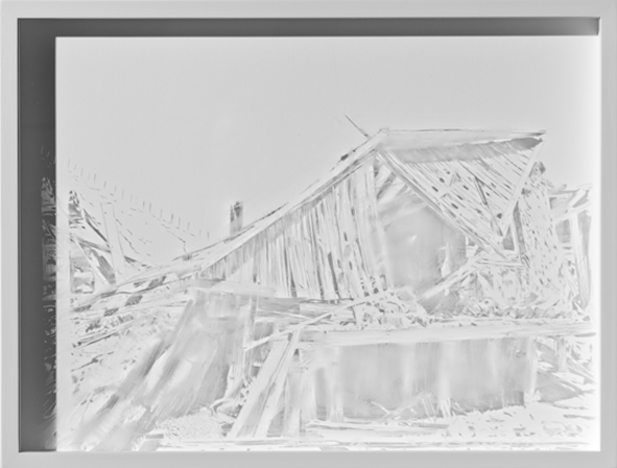
top photo: Joanne Lefrak, "Cabezon Mercantile" 13 x 17 inches / scratched Plexiglas / 2010
Review: “Past As Presence”: Joanne Lefrak
White images, scratches on Plexiglas, reflecting on the white light of history, the urge to indelible amid the prevalence of invisible. In World War II, the United States dropped atomic bombs on Hiroshima and Nagasaki. The controversial testing of those bombs, which occurred prior to the obliteration of the two Japanese cities, took place near San Antonio, New Mexico on July 16, 1945. The location of the first nuclear explosion is called Trinity Site.
Seldom would the view of a beautiful New Mexico landscape with mountains and giant sky conjure thoughts of abysmal destruction. However, the Trinity Site is loaded with history, deep within the memory of its grounds. Artist Joanne Lefrak focuses on unassumingly startling landscapes, such as the Trinity Site, in her latest exhibition “Past As Presence” at Box Gallery in Santa Fe, New Mexico.

Tinity Site (Ground Zero) 34 x 26 inches / scratched Plexiglas / 2009 / SOLD
For Lefrak “no landscape is empty,” and “nothing is a clean slate,” which she equates to apperception. Explained by French philosopher Maurice Merleau-Ponty, apperception inextricably binds all perception to its context. Lefrak, in turn, doesnt separate the quiet wilderness of todays Trinity Site, to the intensity of its yesterday. Quoting Faulkner, Lefrak says, “The past is never dead.”
I asked Lefrak if there was anyway the past could die (e.g. memory loss). “No,” responds the artist. Even if the person is specifically unaware of past events, the memory persists in some capacity, albeit abstracted, or obscured-similar to Lefraks landscapes, which often bear no resemblance to the stories of their past. However, empirical data attests something happened there! The ability to understand, or bring the appropriate perspective to the place depends on the limitations of our own perspective, or apperception. This insinuates, as does the artists work, that we humans are unable to see all that exists not because its lost, only that it is lost to us. Layers of meaning deepen our understanding, thus, changing our perspective.
The landscapes Lefrak chooses to depict must imbue intense aura. Lead scientist at the Trinity Site, J. Robert Oppenheimer (1904-1967), considered the startling reality that testing such an unfathomably great force (like the atomic bomb) could plausibly ignite the atmosphere and end the world, recounts Lefrak, and they did it anyway! Its this historical intensity that attracts the artist to a specific location. Emphasizing tone, the artist illuminates certain historical obscurities through the formal elements of her work.
Lefraks Plexiglas etchings are precise, including representational detail with accuracy. However, because the artist etches Plexiglas, which is clear, the overall feeling of the “drawings” seems ethereal, subtle, and ghostly. The appearance of darker strokes is caused only by shadows. Notice the subtle effect of these drawings in Trinity Site (On the Outskirts of Ground Zero) (below). Another important component to Lefraks art is light-a light source must be present for the drawing to appear at all.

Detail of "Trinity Site (On the Outskirts of Ground Zero)" by Joanne Lefrak
Each formal element in Lefraks work holds a deeper allegory. Painstaking detail speaks to moments of mental clarity, historical truths, and the deeper human understanding of (in the instance of the Trinity Site) place. Like the light casting over a Lefrak drawing, discovering that a landscape holds more meaning than initially meets the eye is revelatory. The light source hitting the Plexiglas to reveal an image correlates to the experience of discovering truth, or learning something new. However, the tenuousness of the light source suggests the ease with which the past can be distorted, or obscured. The shadow play reminds viewers that every place carries a history beneath its surface. And, the ethereal look of the drawings requires careful focus on each scene. This is an invitation from the artist to go deeper in your understanding in order to change your perspective.
Ghost towns like that of Cabezon, New Mexico also bear intrigue for the artist. Lefraks process includes research, and unmediated experience of place. “Past As Presence” includes drawings of Cabezon, as well as an audio component. Lefrak interviewed the last soul in Cabezon, Stan Lucero, recording his stories to prevent them from going untold in future generations. Cabezon once had a booming economy, but now rests in decline.
While ghost towns, and atomic bomb sites seem to transmit negative connotations, Lefrak looks to other intensely charged locations for future projects, like spiritual centers, or border crossings. “Its a statement about our relationship to place,” says Lefrak referring to her work, “Its about understanding.”
The nature of seeing and understanding is complex. It might be easy to assume, for instance, that all blue jays are identical, until we really look at each blue jay to discover differences, recalls Lefrak referring to James Elkins. Ultimately, for the artist, “understanding and wisdom leads to bliss not ignorance,” which resonates in her work. Its all out there (the truth and wisdom), and youve just got to change your perspective to see it! Metaphorically Lefrak calls us to seek out the differences in every blue jay.
